I will start this review off by saying this movie gets ALL the stars. It is a truly amazing film that will garner heaps of praise and you’ll need to dig through to find the very few nitpicky-level of complaints. I’ll warn you now: Spoilers are coming! So, if you haven’t seen Spider-Man: Across the Spider-Verse yet, definitely get out there and see it before you return to read this review.
General Impression:
The purpose of a good sequel is to build upon the foundation created by the first movie, to adhere to the rules established, and finally tread new ground if possible (this mainly applies to fantasy, sci-fi, and comic book movies). Across the Spider-Verse maintains a lot of the things that made the first movie so fantastic. Self-aware jokes, stunningly gorgeous visuals, and a surprisingly down-to-earth story at the center of a completely fantastical adventure. We do lose some of Miles’ internal monologue this time and the humor is less focused on his adaptation to his new-found powers, but mostly this movie is designed to take everything good from the first one and kick it up ALL the notches. And I would say it does so in spectacular fashion.
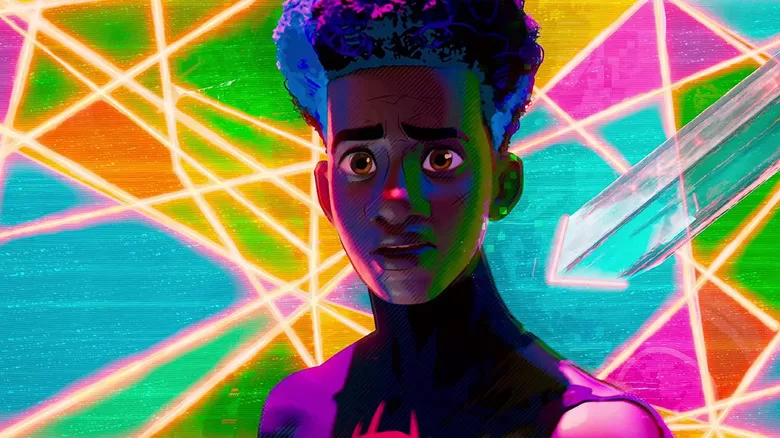
Plot:
Where Into the Spider-Verse was a journey of self-discovery wrapped in a superhero skin, Across the Spider-Verse is a test of that newfound self in every sense of the word. Not only is Miles’ place in the Spider-Verse turned on its head, but the friends he made from the first movie return only to confuse his situation more. Funnily enough, his family provides the kind of stability he needs right now even as his secret identity threatens to widen an already growing gap between them. These very relatable emotional hurdles live comfortably alongside ones that would only apply to a superhero – for example, confronting a new villain-of-the-week only to discover he’s a nemesis and facing the truth that your actions, while done with the best of intentions, can have dire consequences. Perhaps my favorite part of this film is its understanding that these huge life questions cannot be solved in one two-hour-and-twenty-minute stint. In fact, the best surprise for me was discovering this move ends on a cliffhanger! Beyond the Spider-Verse is coming and I’m here for it.
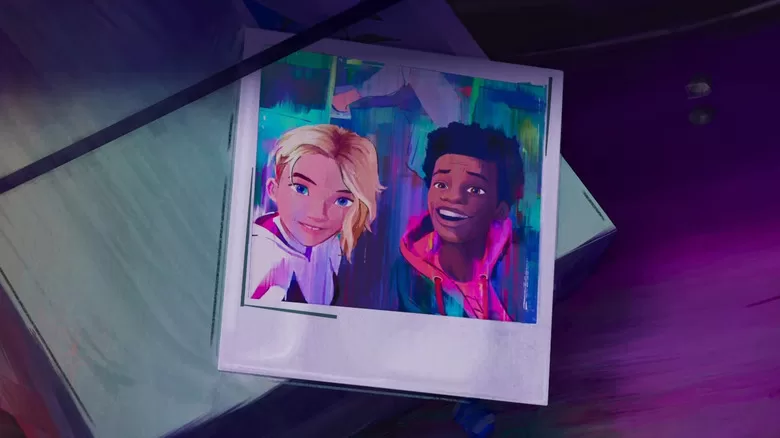
Characters:
The two biggest characters in Across the Spider-Verse are Miles Morales (Shameik Moore) and Gwen Stacy (Hailee Steinfeld). This isn’t entirely surprising as the budding romance between the two serves as a major storyline throughout the movie. Granted, it’s handled with YA style kid-gloves, capturing perfectly the kind of uncertain pull young people can feel towards each other, particularly when they find someone they can truly relate to. It’s also complicated in multiple ways, from other-dimensional long-distance, to potential other suitors, and of course, perceived betrayal. But their individual stories are so well juxtaposed it would be hard to imagine these two crazy kids don’t make it by the end.
Miles Morales has settled into his life as Spider-Man with a few bumps along the way. His super heroics have taken a bite out of his schooling and he admits he’s made some missteps, but what relates him best to Gwen is how he struggles to navigate his relationship with his parents. His father Jeff Morales (Brian Tyree Henry) has just been promoted to police Captain, and wants desperately to celebrate this accomplishment with his wife (Rio Morales voiced by Luna Lauren Velez), and his son, Miles. However, Miles is never around, always running from place to place, and never where he’s supposed to be. Rio suspects her little boy has a secret but she’s afraid to confront him, while Miles fantasizes about revealing his true identity to his folks to a positive outcome. The biggest difference between Miles and Jeff, and Gwen and George (Lt. George Stacy played by Shea Whigham) is that Jeff appears willing to hear Spider-Man out. In fact, the talks he shares with his father as Spider-Man are some of the sweetest moments in the movie because of what it means for the two even if one is in the dark. But, Miles mostly longs for the company of people he doesn’t have to hide his true self from. Namely: Gwen.
Relegated to third string in Into the Spider-Verse, Gwen actually starts off Across the Spider-Verse. Giving us a better idea of her tragic backstory. We also get to see the kind of toll being Spider-Woman takes on her, away from the cool persona she easily wore in Miles’ world, Gwen’s inability to confide in anyone drives her to quit the band she’s joined. Compounding this stress is her tenuous relationship with her policeman father, who hunts for the Spider-Woman convinced she’s responsible for Peter Parker’s death. And, unlike Jeff, George doesn’t seem interested in hearing her side of the story. It’s no wonder that, much like Miles, Gwen’s thoughts often return to the only friend she’s made since losing Peter.
Luckily for her, the spider-verse is happy to make a comeback. In this case it serves as a refuge after revealing herself to be Spider-Woman to her father goes horribly. Gwen makes the painful decision to escape with her spider brethren. However, this time around, there’s new additions.
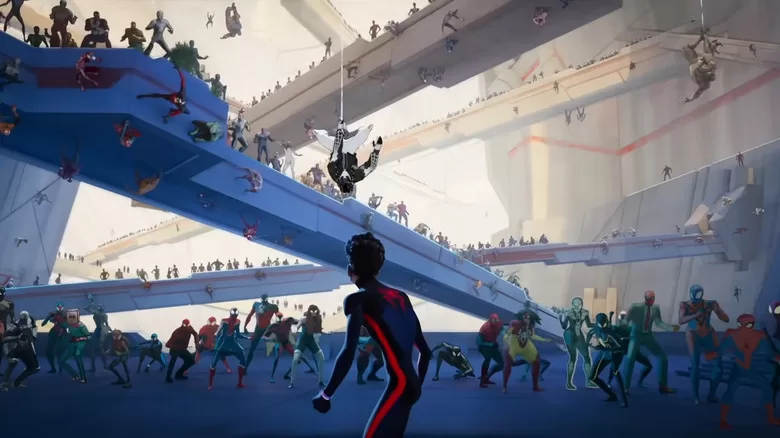
The main players here are Hobi Brown aka Spider-Punk (Daniel Kaluuya), Jessica Drew aka Spider-Woman (Issa Rae), Pavitr Prabhakar aka Spider-Man of Mumbattan (Karan Soni), and Spider-Man 2099 aka Miguel O’Hara (Oscar Isaac doing his best brooding). While Jessica Drew makes the first strike, she is largely sidelined in hologram form for much of the movie. The most we learn about her is she’s pregnant and fiercely devoted to Miguel O’Hara’s cause. Hobi, conversely, is an anarchist, and frankly a strange addition to Miguel’s Spider-Society. A punk that reflexively denounces anything he deems “conformist”, he serves initially as a perceived foil to Miles’ romantic interest in Gwen, but later proves himself to be an ally against Miguel’s unbending mission. Pavitr, a fun-loving, light-hearted addition to this crop of spider-people, also ends up willing to go against Miguel in a bid to save Miles from suffering a tragic fate. So, what exactly is this mission Miguel is so hardline about?
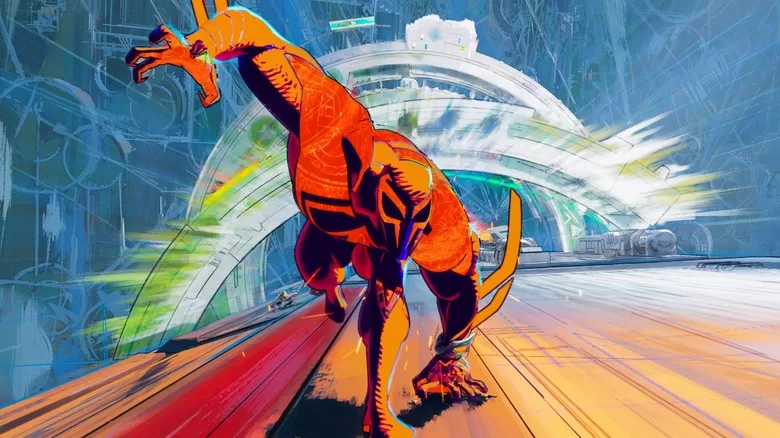
Spider-Man 2099 aka Miguel O’Hara serves as the surprise antagonist of Across the Spider-Verse. You may remember him as a much lighter character in his after-the-credits appearance from the previous movie, but two years later he’s a very different guy. The question then becomes what changed? As tragic origin stories go, Miguel’s is an interesting one. Much like Miles, he’s one of only a handful of non-Peter Parker (or some variation thereof) spider-men. And, while he’s suffered the requisite loss needed to become Spider-Man he also dared to take advantage of a loophole he discovered. Unfortunately, his plan to take the place of his dead-self in another dimension didn’t go so well for the dimension resulting in catastrophic loss of life. This hard-learned lesson makes him into a strict enforcer of what he believes to be the inevitable “canon” that all spider-people must live through. It is this devotion to the canon that eventually pits Miguel (and by extension the whole of the spider-society) against Miles and leads to the most jarring revelation in the movie.
Allow me to preface this by saying that with respect to both building on existing foundations and treading new ground, Across the Spider-Verse takes two minor details from Into the Spider-Verse and builds them into the devastating crux of the sequel. What was initially seen as an easter egg – the repetition of the number “42” is actually a clue, along with the glitching of the spider that bites Miles. Turns out, Miles Morales was never meant to be Spider-Man. That spider didn’t glitch merely as an artistic choice to indicate it’s radioactive, it was glitching because it wasn’t from this dimension. A clue, I, and (I’m going to reassure myself) many others, missed the first time around, despite the fact that glitching is one of the rules the first movie establishes. Funnily enough, though this detail makes for the earth-shattering reveal at the core of the film, it isn’t used much in the movie otherwise. Here and there it returns to remind us spider-people don’t do well outside of their own dimension, to the point that a device is introduced to bypass this rule – it also serves as a punishment of sorts for those spider-people exiled from the spider-society.
Gwen, for example, loses her dimensional watch after rejecting Miguel’s canon rule. Discovering that her disappearance from her own dimension led her father to quit the police force thus changing his own tragic trajectory. Hobi, ever the rebel, creates a bootleg dimensional watch which results in Gwen gathering her own spider-society to come to Miles’ aid. This includes the original cast of alternate spider-people from Into the Spider-Verse.
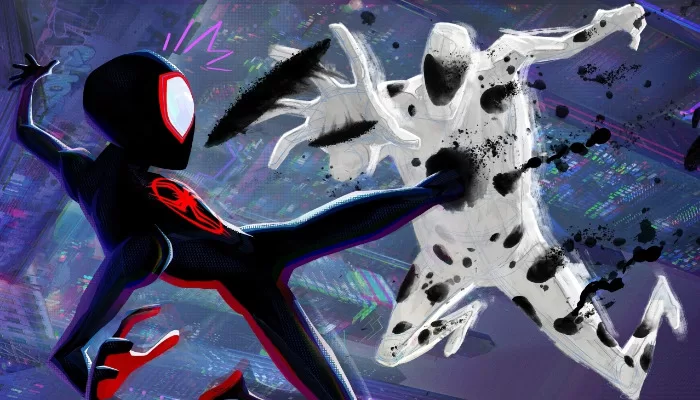
Now, I labeled Miguel as the surprise antagonist because the movie initially pushes The Spot (Jason Schwartzman) as its real villain. Appearing to be just a petty thief at first blush with Miles treating him as such, the Spot is much much more. This naked, faceless, albino has an origin-story-level bone to pick with Miles; deciding that the two are destined for a dark fate, he quickly learns to harness his unique power to the point of crossing into other dimensions. However, the trick isn’t easy, nor does it go unnoticed. It kind of reminds me of Doctor Strange and the Multiverse of Madness where the Illuminati focuses on the wrong threat – brushing off Wanda. The Spot is similarly ignored in favor of Miles, and possibly encouraged where Miguel is concerned because of his role to play in Miles’ “canon.”
Kudos:
Aside from the movie being an overall triumph in my eyes, it’s worth noting that the level of emotional expression the animators are able to attain is staggering, even when the characters have their masks on. Those huge eyes convey equal levels of sorrow, sarcasm, and joy – a feat no live-action superhero movie has a chance of matching. One could argue that all super-hero movies should be animated, especially those with mask-wearing heroes.
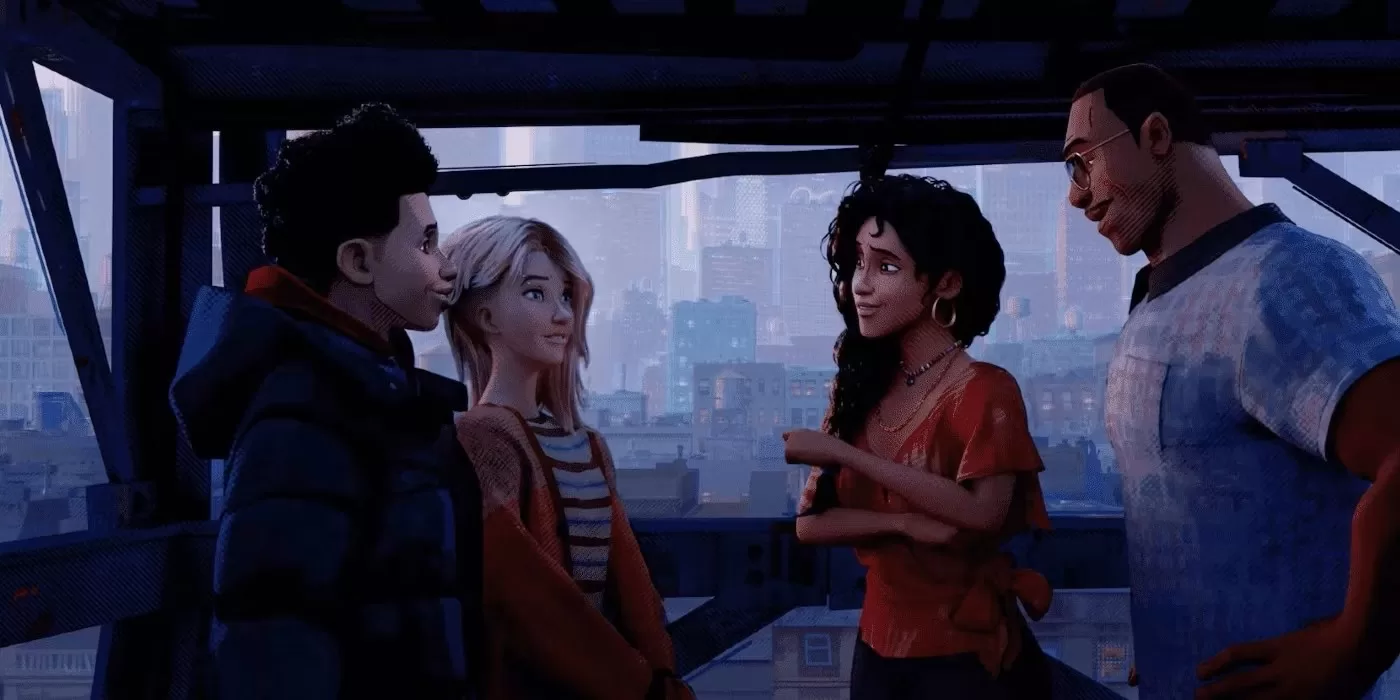
I also give the movie credit for the relationship created between Gwen and Miles, and Miles and his parents as two of the biggest storylines the movie has besides the super-hero centered ones. And to the film’s credit, these relationships are given room to breathe and exist alongside the more extravagant ones.
Gripes:
Here’s a general pet peeve I have with this kind of movie (or shows in the case of What If…). Movies that introduce the marvelous idea of a multiverse only to then immediately constrict what is possible. I’m not a physics major nor have I done much research into the deeper ideas of metaphysics and parallel universes, but given Marvel’s penchant for grounding much of their movie magic in quantifiable science fact or working theory, I would hedge a bet that somewhere in the annals of higher physics the idea of a “set-event” exists. To me, this is problematic. Isn’t the whole point of a multiverse that all things are possible?
Also, where is Madam Web!?
Finally, my three major complaints about this movie are that, one: it is not showing in 3-D yet still has noticeably 3-D elements, two: it does occasionally bask in its own glory (albeit understandably), and third, sometimes the background tries to outshine the show. The second one simply means that after a scene has ended, the camera will linger – art house style – for what can become a slightly painful amount of time, but again, it’s a very minor quibble. The third complaint refers to the fact that there is A LOT going on here – and not just with regards to the various spider-people thrown at you one after another with very little pause for acknowledgment, no, visually speaking while this movie is a feast it could be considered the Thanksgiving gorge-fest of visual feasts.
Gwen Stacy’s world is a good example of this as it consists of gorgeous matte-paint scenes set in calming pastels. This is both a help and a hinderance at times, because while the soft color palette does allow the foreground action and imagery to stand front-and-center it can also be a distraction when allowed to be…well, loud. There’s a very pivotal scene between Gwen and her father that is almost ruined by the background defying its usual support role and trying its hand at being the star. I do understand why it does this, don’t get it twisted, it is a very purposeful application but given how muted and silent her world’s environment is for the majority of her time there the change in atmosphere can be jarring. As for Miles’ world, while his environment is busy and loud naturally, when it gives being quiet or scenic a try the effort is noticeable.
Could the pacing overall have been better? Absolutely, but considering this movie turned out to be a continuation, the pacing is forgivable. I would argue the lags are at least worth the slow down.
Bottom Line:
See this movie in a theatre full of people. You will not regret it.
